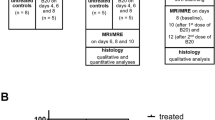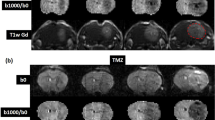Summary
Human gliobastomas of the brain are characterized by a wide range of proton relaxation ratesin vitro (1/T1 and 1/T2) and heterogeneous appearance in magnetic resonance imaging. It was previously found that their 1/T1 values vary widely at magnetic field strengths much below imaging fields, even at the same water content. In the present study, we measure 1/T1 at different magnetic field strengths (NMRD profile) for a specific transplantable, human glioblastoma (SF295), grown subcutaneously in athymic nude mice, to search for histologic characteristics that might correlate with the variability of 1/T1 at low fields (1/T1L).
Using a field-cycling relaxometer, NMRD profiles were obtained for 32 fresh, histologically characterized, tumor specimens, 7 to 24 days post implantation of cryopreserved SF295 fragments. Tumor volume, dry weight, and pH of specimens were determined, the extent of hemorrhage and necrosis rated, and specimen location within the tumor recorded.
A statistically significant increase in the average 1/T1 was found with increasing level of necrosis at 0.0024 T and below, possibly reflecting progressive protein aggregation in samples with up to 40% necrosis. This correlation was not significant at imaging fields. Although pH was increased in central necrosis, neither pH, dry weight, sample location, nor fresh hemorrhage could explain the changes in 1/T1L. The variability of 1/T1L among SF295 samples is much reduced compared to that of fresh surgical specimens of human glioblastomas of the brain.
The heterogeneous appearance of glioblastomas in MRI may have a histologic correlate which reflects molecular changes involved with induction of cell death and necrosis. Further investigations may identify the factors responsible for affecting 1/T1L (hypoxia, radiation, chemotherapy).
Similar content being viewed by others
References
Koenig SH, Brown III RD: Relaxometry of tissue. In: Gupta RK (ed) NMR Spectroscopy of Cells and Organisms, CRC Press, Boca Raton, Vol II, 75–114, 1987
Lundbom N, Brown III RD, Koenig SH, Lansen TA, Valsamis MP, Kasoff SS: Magnetic field dependence of 1/T1 of human brain tumors. Correlations with histology. Invest Radiol 25: 1197–1205, 1990
Spiller M, Kasoff SS, Lansen TA, Rifkinson-Mann S, Valsamis MP, Koenig SH, Tenner MS: Variation of the magnetic relaxation rate 1/T1 of water protons with magnetic field strength (NMRD Profile) of untreated, non-calcified, human astrocytomas: correlation with histology and solids content. J Neur Onc 21: 113–125, 1994
Rutka JT, Giblin JR, Dougherty DY, Liu HC, McCulloch JR, Bell CW, Stern RS, Wilson CB, Rosenblum ML: Establishment and characterization of live cell lines derived from human malignant gliomas. Acta Neuropathol (Berlin) 75: 92–103, 1987
Dykes DJ, Abbott BJ, Mayo JG, Harrison Jr SD, Laster WR, Simpson-Herren L, Griswold Jr DP: Development of human tumor xenograft models forin vivo evaluation of new antitumor drugs. Contrib Oncol 42: 1–22, 1992
Kamman RL, Go KG, Muskiet FAJ, Stomp GP, Van Dijk P, Berendsen HJC: Proton spin relaxation studies of fatty tissue and cerebral white matter. Magn Reson Imaging 2: 211–220, 1984
Cole KS, Cole RH: Dispersion and absorption in dielectrics. J Chem Phys 9: 341–351, 1941
Kasoff SS, Spiller M, Valsamis MP, Lansen TA, Duffy KR, Koenig SH, Tenner MS: Relaxometry of non-calcified human meningiomas. Correlation with histology and solids content. Invest Radiol 30: 49–55, 1995
Hyman TJ, Kurland RJ, Levy GC, Shoop JD: Characterization of normal brain tissue using seven calculated MRI parameters and a statistical analysis system. Magn Reson Med 11: 22–34, 1989
Agartz I, Saaf J, Wahlund LO, Wetterberg L: T1 and T2 relaxation time estimates in the normal human brain. Radiology 181: 537–543, 1991
Koenig SH, Brown III RD, Adams D, Emerson D, Harrison CG: Magnetic field dependence of 1/T1 of protons in tissue. Invest Radiol 19: 76–81, 1984
Bottomley PA, Foster TH, Argersinger RE, Pfeifer LM: A review of normal tissue hydrogen NMR relaxation times and relaxation mechanisms from 1–100 MHz: dependence on tissue type, NMR frequency, temperature, species, excision, and age. Med Phys 11: 425–448, 1984
Koenig SH, Brown III RD, Spiller M, Lundbom N: Relaxometry of brain: why white matter appears bright in MRI. Magn Reson Med 14: 482–495, 1990
Rinck PA, Fischer HW, Vander Elst L, Van Haverbeke Y, Muller RN: Field-cycling relaxometry: medical applications. Radiology 168: 843–849, 1988
Sepponen RE, Sipponen JT, Sivula A: Low field (0.02 T) nuclear magnetic resonance imaging of the brain. J Comput Assist Tomogr 9: 237–241, 1985
Bilaniuk LT, Zimmerman RA, Wehrli FW, Goldberg HI, Grossman RI, Bottomley PA, Edelstein WA, Glover GH, MacFall JR, Redington RW,et al.: Cerebral magnetic resonance: comparison of high and low field strength imaging. Radiology 153: 409–414, 1984
Wolf GL, Sullenberger PC, Bickerstaff KJ: The influence of mild dehydration upon tissue proton relaxation rates is reversible. Sixth Annual Scientific Meeting of the Society of Magnetic Resonance in Medicine, Books of Abstracts: 1: 434, 1987
Györffy-Wagner Z, Englund E, Larsson EM, Brun A, Cronqvist S, Petersson B: Proton magnetic resonance relaxation times T1 and T2 related to postmortem interval. An investigation on porcine brain tissue. Acta Radiol Diagn 27: 115–118, 1985
Darwin RH, Drayer BP, Riederer SJ, Wang HZ, MacFall JR: T2 estimates in healthy and diseased brain tissue: A comparison using various MR pulse sequences. Radiology 160: 375–381, 1986
Henkelman RM, Watts JF, Kucharczyk W: High signal intensity in MR images of calcified brain tissue. Radiology 179: 199–206, 1991
Bradley WG: MR detection of intracranial calcification: A phantom study. AJNR 8: 1049–1055, 1987
Gomori JM, Grossman RI, Yu-Ip C, Asakura T: NMR relaxation times of blood: dependence on field strength, oxidation state, and cell integrity. J Comput Assist Tomogr 11: 684–690, 1987
Thulborn KR, Sorensen AG, Kowall NW, McKee A, Lai A, McKinstry RC, Moore J, Rosen BR, Brady TJ: The role of ferritin and hemosiderin in the MR appearance of cerebral hemorrhage: a histopathologic biochemical study in rats. AJNR 11: 291–297, 1990
Kormano M, Raininko R, Katevuo K: Magnetic resonance imaging of intracranial neoplasms at 0.02 Tesla. Acta Radiol 28: 369–373, 1987
Brant-Zawadski M, Kelly W: Brain tumors. In: Brant-Za-wadski M, Norman D (eds) Magnetic Resonance Imaging of the Central Nervous System, Raven Press, New York, 151–185, 1987
Englund E, Brun A, Larsson EM, Györffy-Wagner Z, Persson B: Tumours of the central nervous system. Proton magnetic resonance relaxation times T1 and T2 and histopathologic correlates. Acta Radiol Diagnosis 27: 653–659, 1986
Spiller M, Tenner MS, Kasoff SS, Lansen TA, Rifkinson-Mann S, Duffy K, Valsamis MP, Brown III RD, Koenig SH: 1/T1 Relaxivity of intracranial and intraspinal tumors. Correlation with histology and MTC. Twelfth Annual Scientific Meeting. Proceedings of the Society of Magnetic Resonance in Medicine 1: 144, 1993
Mangiardi JR, Yodice P: Metabolism of the malignant astrocytoma (Review article). Neurosurgery 26: 1–19, 1990
Kökoglu E: RNA, DNA and total protein levels in subcellular fractions of human brain tumors. Cancer Letters 34: 67–71, 1987
Englund E, Brun A, Györffy-Wagner Z, Larsson EM, Persson B: Relaxation times in relation to grade of malignancy and tissue necrosis in astrocytic gliomas. Magn Reson Imaging 4: 425–429, 1986
Sillerud LO, Freyer JP, Neeman M, Mattingly MA: Proton NMR microscopy of multicellular tumor spheroid morphology. Magn Reson Med 16: 380–389, 1990
Brant-Zawadzki M, Norman D, Newton TH,et al.: Magnetic resonance of the brain. The optimal screening technique. Radiology 152: 71–77, 1984
Peterman SB, Steiner RE, Bydder GM: Magnetic resonance imaging of intracranial tumors in children and adolescents. AJNR 5: 703–709, 1984
Choi BI, Lee DH, Han MC: Necrotic areas in VX2 carcinoma of rabbits. Correlation of magnetic resonance imaging and pathologic appearance. Invest Radiol 28: 33–38, 1993
Rhodes ES, Bacic G, Ohara JA, Liu KJ, Swartz HM, Dunn JF: MRI guided oximetry: measuring oxygen in viable and necrotic regions in murine tumors. Second Scientific Meeting. Proceedings of the Society of Magnetic Resonance 2: 858, 1994
Koenig SH, Beaulieu CF, Brown RD, Spiller M: Oligomerization and conformation change in solutions of calf lens γn-crystallin. Results from 1/T1 nuclear magnetic relaxation dispersion profiles. Biophys J 57: 461–469, 1990
Koenig SH, Brown III RD: A molecular theory of relaxation and magnetization transfer: application to cross-linked BSA, a model for tissue. Magn Reson Med 30: 685–695, 1993
Kornblith PL: Management of malignant gliomas. Neurosurgery Quarterly 1: 97–110, 1991
Winter F, Kimmich R: NMR field-cycling spectroscopy of bovine serum albumin, muscle tissue, micrococcus luteus and yeast.14N1H-quadrupole dips. Biochim Biophys Acta 719: 292–298, 1982
Beaulieu CF, Clark JI, Brown III RD, Spiller M, Koenig SH: Relaxometry of calf lens homogenates, including cross-re-laxation by crystallin NH groups. Magn Reson Med 8: 45–57, 1988
Author information
Authors and Affiliations
Rights and permissions
About this article
Cite this article
Spiller, M., Merker, P.C., Iatropoulos, M.J. et al. Correlation of relaxometry and histopathology: the transplantable human gliobastoma SF295 grown in athymic nude mice. J Neuro-Oncol 25, 113–126 (1995). https://doi.org/10.1007/BF01057755
Issue Date:
DOI: https://doi.org/10.1007/BF01057755




